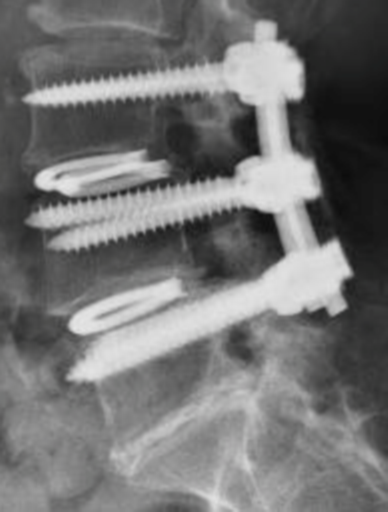Posterior lumbar interbody fusion PLIF
Posterior lumbar interbody fusion PLIF (PP code V3362)
Patients with a symptomatic slipped vertebra (spondylolisthesis) may require a complex spinal fusion to decompress trapped nerves and stabilise the spine. This is aimed at improving the patient’s leg symptoms. Whilst it may improve some back symptoms, it will not cure back pain. The operation is usually only carried out when more conservative measures have been tried and failed.
The risks of surgery include:
- infection
- bleeding
- spinal fluid leak
- DVT/PE (clots in legs / lungs)
- scar tissue
- reoperation
- recurrent symptoms
- accelerated degeneration
- implant failure
- nerve root injury
- pain, numbness
- weakness, paralysis
- incontinence, impotence
- general anaesthetic complications (heart attack, stroke)

The operation is carried out under a general anaesthetic and lasts approximately 150 minutes. It involves making a linear incision down the middle of the back. The operation takes longer than a simple decompression as it involves stabilising the spine with screws, rods and fusion cages. The incision is usually longer (10-15cm) but new minimally invasive techniques are currently under trial and may result in a smaller incision and less muscle damage.
The wound is closed usually skin clips, which will need to be removed after 7-10 days. After the operation the patient will have a drain in the wound for 24 hours (this is removed on the ward before discharge). Most patients will go home the next day and will be recovering at home for approximately 6 weeks. Following surgery the patient may notice some new back pain and stiffness but this should settle with simple anti-inflammatory medication such as ibuprofen. Some patients will develop tingling in the legs after surgery due to swelling around the nerves at the site of the operation. This is temporary and will usually settle down after a few days.
Patients do not usually need to wear a back brace or support. Specialist spinal physiotherapists will advice each patient on a postoperative exercise regime, to encourage neck movements. Further outpatient physiotherapy sessions will be offered, where indicated.
Useful Links


